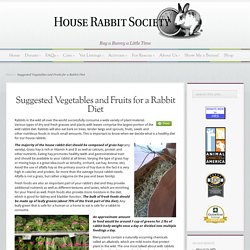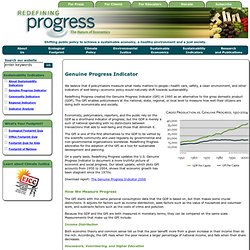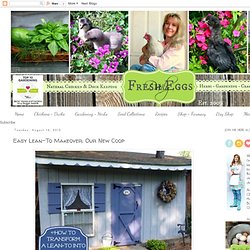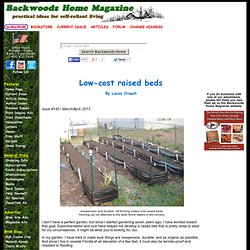

Suggested Vegetables and Fruits for a Rabbit Diet. Rabbits in the wild all over the world successfully consume a wide variety of plant material.

Various types of dry and fresh grasses and plants with leaves comprise the largest portion of the wild rabbit diet. Rabbits will also eat bark on trees, tender twigs and sprouts, fruits, seeds and other nutritious foods in much small amounts. This is important to know when we decide what is a healthy diet for our house rabbits. The majority of the house rabbit diet should be composed of grass hay (any variety). Grass hay is rich in Vitamin A and D as well as calcium, protein and other nutrients. Fresh foods are also an important part of your rabbit’s diet and they provide additional nutrients as well as different textures and tastes, which are enriching for your friend as well. Redefining Progress - Genuine Progress Indicator.
How We Measure Progress The GPI starts with the same personal consumption data that the GDP is based on, but then makes some crucial distinctions.

It adjusts for factors such as income distribution, adds factors such as the value of household and volunteer work, and subtracts factors such as the costs of crime and pollution. Because the GDP and the GPI are both measured in monetary terms, they can be compared on the same scale. Measurements that make up the GPI include: Income Distribution Both economic theory and common sense tell us that the poor benefit more from a given increase in their income than do the rich. Soil survivor: An interview with urban farming legend Will Allen. Will Allen.

(Photo by Growing Power.) In his new autobiographical book, The Good Food Revolution: Growing Healthy Food, People, and Communities, we see a different side of MacArthur Genius and urban farmer Will Allen. The book takes readers behind the scenes to witness the process of trial and error behind Growing Power, the Milwaukee-based urban farm, CSA, and youth training program that put Allen on the map. Compost: How to Make It, Bins, Piles and More.
Coop Designs. Test Chicken Acceptance! 30 things you should never compost or recycle. Remember the good ol' days — back when we only had one bin for trash?

In retrospect, those days were actually more wasteful than good. We sent things to the landfill that might have nourished our yards, and buried them side-by-side with materials that should have been reclaimed and put back in the production chain. Today, most of us have two bins: one for compost and another for recycling. They're great for reducing curbside trash, but not everything is suitable for those bins. We've rounded up 30 things people mistakenly try to compost or recycle. Bread products: This includes cakes, pasta and most baked goods. Cooking oil: Smells like food to animal and insect visitors. Diseased plants: Trash them, instead. Easy Lean-To Makeover: Our New Coop. We needed a new coop.

Our flock had just continued to grow over the last few years but, sadly, our coop hadn't. Bottle Drip Irrigation. I prefer to have the bottle standing right-way-up as I think it looks nicer and it keeps debris out of the bottle thus keeping the holes from blocking.

The materials: * 2 litre plastic soft-drink bottle or water bottle * Sharp small screwdriver, pointed hole-maker or drill This can be used in container gardening, raised bed gardens and open vegetable gardens. Using your pocket knife, make 2 small slits in the bottom of your bottle. Make two more small slits half way up your bottle. Dig a hole next to your tomato plant. This will slowly deep-water your tomato plants and most other vegetable plants.
Building Your Compost Pile - Composting for the Homeowner. Different Types of Wood Fired Soaking Hot Tubs. Low-cost raised beds by Lucas Crouch. Inexpensive and durable, silt fencing makes nice raised beds.Fencing can be attached to the taller fence stakes in the corners.

I don't have a perfect garden, but since I started gardening seven years ago, I have worked toward that goal. Experimentation and luck have helped me develop a raised bed that is pretty close to ideal for my circumstances. Sweet Sorghum Revival: How to Grow Your Own Natural Sweetener - Modern Homesteading. I grew up helping my family make sweet sorghum syrup.

I remember the sorghum canes growing in our garden, and the late summer day we harvested our crop. I loved the long day with family and friends, Dad readying the equipment, and Mom making sure everyone was fed. After Dad passed away, I became determined that my children would continue to play a part in producing this delicious, homegrown, natural sweetener. Sorghum-making is a way to increase your food self-sufficiency, but more than that, it’s a meaningful tradition you can add to your homestead. A past call-out in MOTHER EARTH NEWS for sorghum-making stories led to a flow of memories, photos and recipes centered on sweet sorghum syrup.
Don't miss the plans for a DIY sorghum press, submitted by a reader as a follow-up to the original printing of this article. What Is Sorghum Syrup?